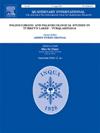Pompeii: Seeds and fruits from workshop VII 14, 3
IF 1.9
3区 地球科学
Q3 GEOGRAPHY, PHYSICAL
引用次数: 0
Abstract
This paper presents a study of carpological remains discovered at Pompeii (VII 14, 3) during archaeological investigations conducted by the University of Genoa. Samples were collected from contexts spanning from the late 3rd century BC to 79 AD. During this time-frame, the area underwent numerous transformations, serving consecutively as an open space with latrines, a disposal site for domestic waste, a location for craft workshops, and ultimately hosting a workshop.
Except for a few samples preserved for future analysis, sediments from the contexts examined underwent thorough water-sieving on a declining-mesh sieve column and simultaneous flotation. The material examined comes from 60 samples (15 obtained via visual inspection and 45 by means of flotation) relating to 29 stratigraphic units, totalling approximately 2.2 m3 of soil.
Given the sealed and undisturbed nature of these contexts, the consistent composition of accumulations derived from faeces and food remains, in both the older and newer latrines and the refuse dump, suggests a continuity in dietary choices lasting several centuries, despite the evolving use of the area.
Carpological remains provide minimal evidence of natural environments or other anthropized contexts, highlighting the cleanliness and orderliness of the area occupied by latrines and the refuse dump, which functioned as a well-maintained courtyard.
The collective data suggest that this part of the city was already fully urbanized by the 2nd century BC. Stratigraphic evidence indicates continued activity even after the foundation of the Roman colony, portraying a diverse consumption pattern including various major cereals (Hordeum and Triticum spp.), along with millet and foxtail millet, some legumes, other vegetables, and abundant fruits.
庞贝:车间VII的种子和果实14,3
本文介绍了热那亚大学在考古调查期间在庞贝(VII 14,3)发现的考古遗迹的研究。样本是从公元前3世纪晚期到公元79年的环境中收集的。在这段时间内,该地区经历了多次改造,先后成为带有厕所的开放空间、家庭垃圾处理场、工艺作坊的所在地,并最终成为一个车间。除了为将来分析而保留的少数样品外,研究环境中的沉积物在下降网筛柱上进行了彻底的水筛和同时浮选。所检查的材料来自60个样本(15个通过目测获得,45个通过浮选获得),涉及29个地层单位,总计约2.2立方米的土壤。考虑到这些环境的封闭和不受干扰的性质,在旧的和新的厕所和垃圾场中,粪便和食物残留物的累积成分一致,表明尽管该地区的用途不断演变,但饮食选择的连续性持续了几个世纪。考古遗迹提供了自然环境或其他人为环境的最小证据,突出了厕所和垃圾场占据的区域的清洁和秩序,它作为一个维护良好的庭院。综合数据表明,这部分城市在公元前2世纪就已经完全城市化了。地层证据表明,即使在罗马殖民地建立之后,这种活动仍在继续,描绘了一种多样化的消费模式,包括各种主要谷物(Hordeum和Triticum),以及小米和谷子,一些豆类,其他蔬菜和丰富的水果。
本文章由计算机程序翻译,如有差异,请以英文原文为准。
求助全文
约1分钟内获得全文
求助全文
来源期刊

Quaternary International
地学-地球科学综合
CiteScore
5.60
自引率
4.50%
发文量
336
审稿时长
3 months
期刊介绍:
Quaternary International is the official journal of the International Union for Quaternary Research. The objectives are to publish a high quality scientific journal under the auspices of the premier Quaternary association that reflects the interdisciplinary nature of INQUA and records recent advances in Quaternary science that appeal to a wide audience.
This series will encompass all the full spectrum of the physical and natural sciences that are commonly employed in solving Quaternary problems. The policy is to publish peer refereed collected research papers from symposia, workshops and meetings sponsored by INQUA. In addition, other organizations may request publication of their collected works pertaining to the Quaternary.
 求助内容:
求助内容: 应助结果提醒方式:
应助结果提醒方式:


